Inside the World’s Only Surviving Tattoo Shop For Medieval Pilgrims
The Razzouk family has been inking religious pilgrims in the Middle East for 700 years.
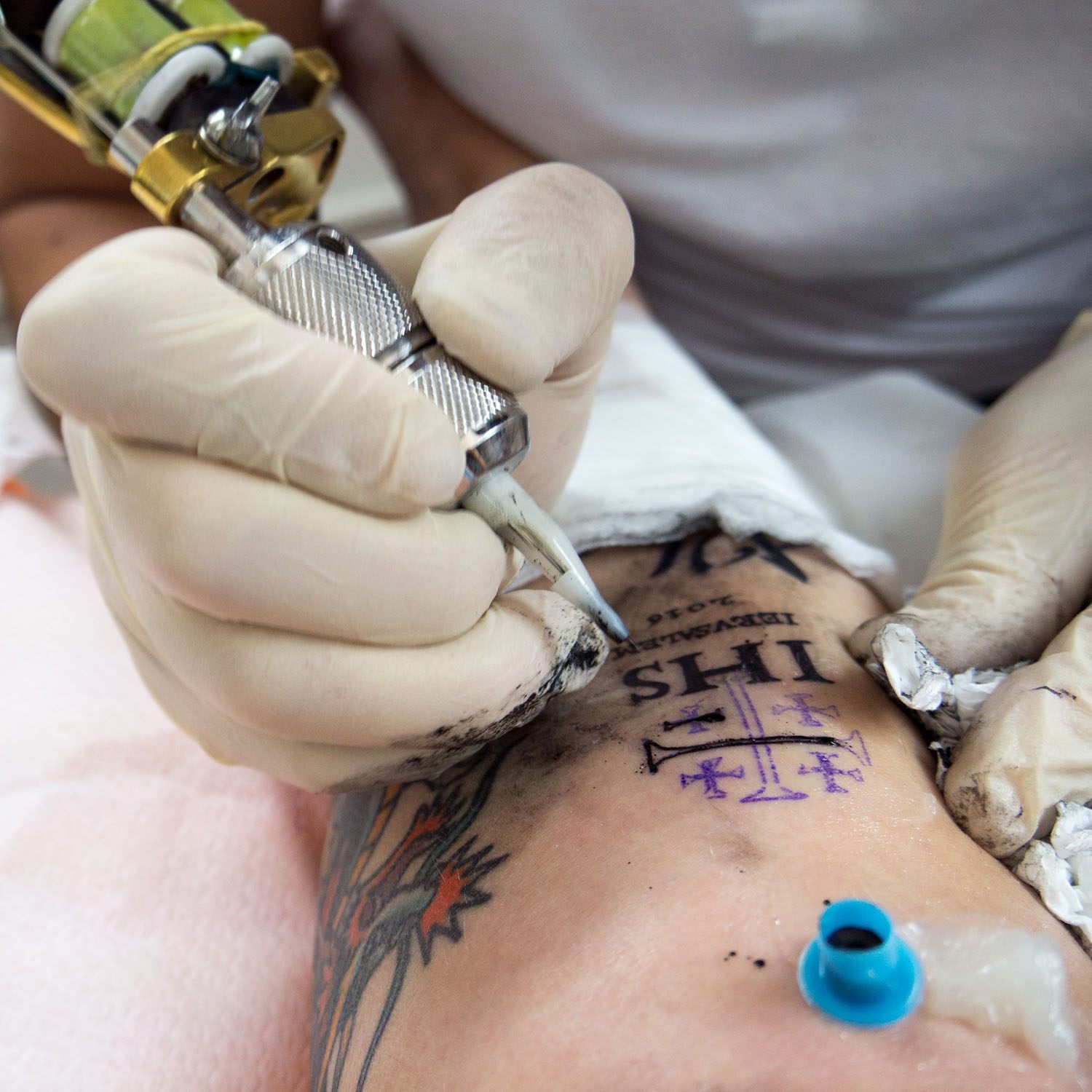
Wassim Razzouk tattooing the classic Jerusalem Cross motif known to look exactly like this since at least the early 1600s.(All Photos: Anna Felicity Friedman)
In Jerusalem’s Old City today, you can find a uniquely obscure historical relic—the sole surviving pilgrimage tattoo business, Razzouk Ink. It’s a place where ancient artifacts meet contemporary machines, rich history intersects with modern technology. Twenty years ago, as a budding tattoo scholar, I first read about the adventures of Christian pilgrims to the Holy Land and the indelible souvenirs they had inscribed under their skin. I never expected to one day get the opportunity to follow in their footsteps and receive my own.
Just inside the Jaffa Gate in Jerusalem’s Old City, you can duck down the second side street to the left, as I did, finding respite from the beating sun and leaving the bustle of the crowded main square. A tiny shop, almost dwarfed by its prominent sign, lies across a quiet cobblestone road. If you didn’t know anything about the incredible, centuries-long history of the family who runs this particular shop, the sign’s tagline might cause you to do a double-take: “Tattoo With Heritage Since 1300” it reads.
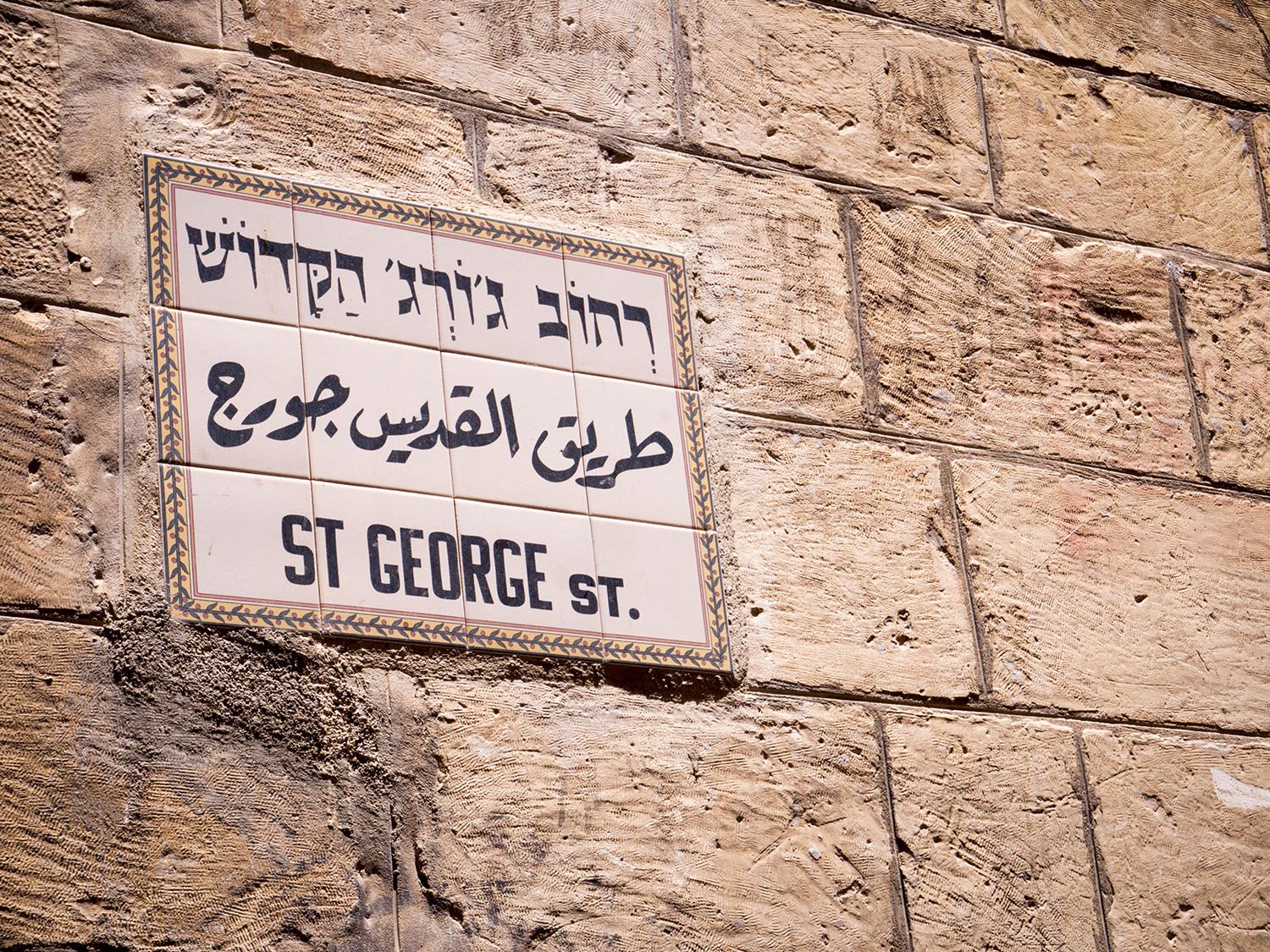
St. George Street seems a particularly appropriate location, since St. George and the Dragon is a common pilgrimage tattoo motif.
For 700 years the Razzouk family has been tattooing marks of faith. Coptic Christians who settled in Jerusalem four generations ago, the family had learned the craft of tattooing in Egypt, where the devout wear similar inscriptions. Evidence of such tattoos dates back at least as far as the 8th century in Egypt and the 6th century in the Holy Land, where Procopius of Gaza wrote of tattooed Christians bearing designs of crosses and Christ’s name. Early tattoos self-identified indigenous Christians in the Middle East and Egypt. Later, as the faithful came to the Holy Land on pilgrimage, the practice expanded to offer these travelers permanent evidence of their devotion and peregrination.
Upon entering Razzouk Ink, you will discover a blend of stone walls and exposed beams lending antique character to the space, while the sterile tattoo parlor hides behind a wall. A museum-like case holds family antiques, and an exhibition of pictures on the walls offers glimpses into the family’s past.
Family lore dates the Razzouk’s involvement in this cultural practice to 1300, starting first in Egypt among Coptic (Orthodox) Christians and later in the Holy Land for Christians from a variety of backgrounds. “My ancestors were always in association with the church therefore it might be they learned this practice from there,” says Wassim Razzouk, the current family tattooer.

Wassim Razzouk in his shop which evokes a blend of history and contemporary culture.
Pilgrims’ accounts dating to the late 16th century offer a glimpse into the era’s tattoo culture, and how purveyors such as the Razzouks must have tattooed back then, with sewing needles bound to the end of a wooden handle. Such accounts report designs that have become enduring pilgrimage tattoos, such as the Jerusalem cross—a motif consisting of a central, equal-arm symbol flanked by four smaller versions—along with images of Christ, Latin mottoes, dates in banners, and more.
A comprehensive description of the historical technique comes from Reverend Henry Maundrell, a chaplain for the English Levant Company’s office in Aleppo, Syria. In 1697, on the day before Easter, he witnessed the tattooing process in Jerusalem on a group of Christian pilgrims traveling with him. Maundrell writes:
The next morning nothing extraordinary pass’d, which gave many of the Pilgrims leisure to have their Arms mark’d with the usual ensigns of Jerusalem. The artists who undertake the operation do it in this manner. They have stamps in wood of any figure that you desire; which they first print off upon your Arm with powder of Charcoal; then taking two very fine Needles, ty’d close together, and dipping them often, like a pen in certain Ink, compounded as I was inform’d of Gunpowder, and Ox-Gall, they make with them small punctures all along the lines of the figure which they have printed, and then washing the part in Wine conclude the work. These punctures they make with great quickness and dexterity, and with scarce any smart, seldom piercing so deep as to draw blood.
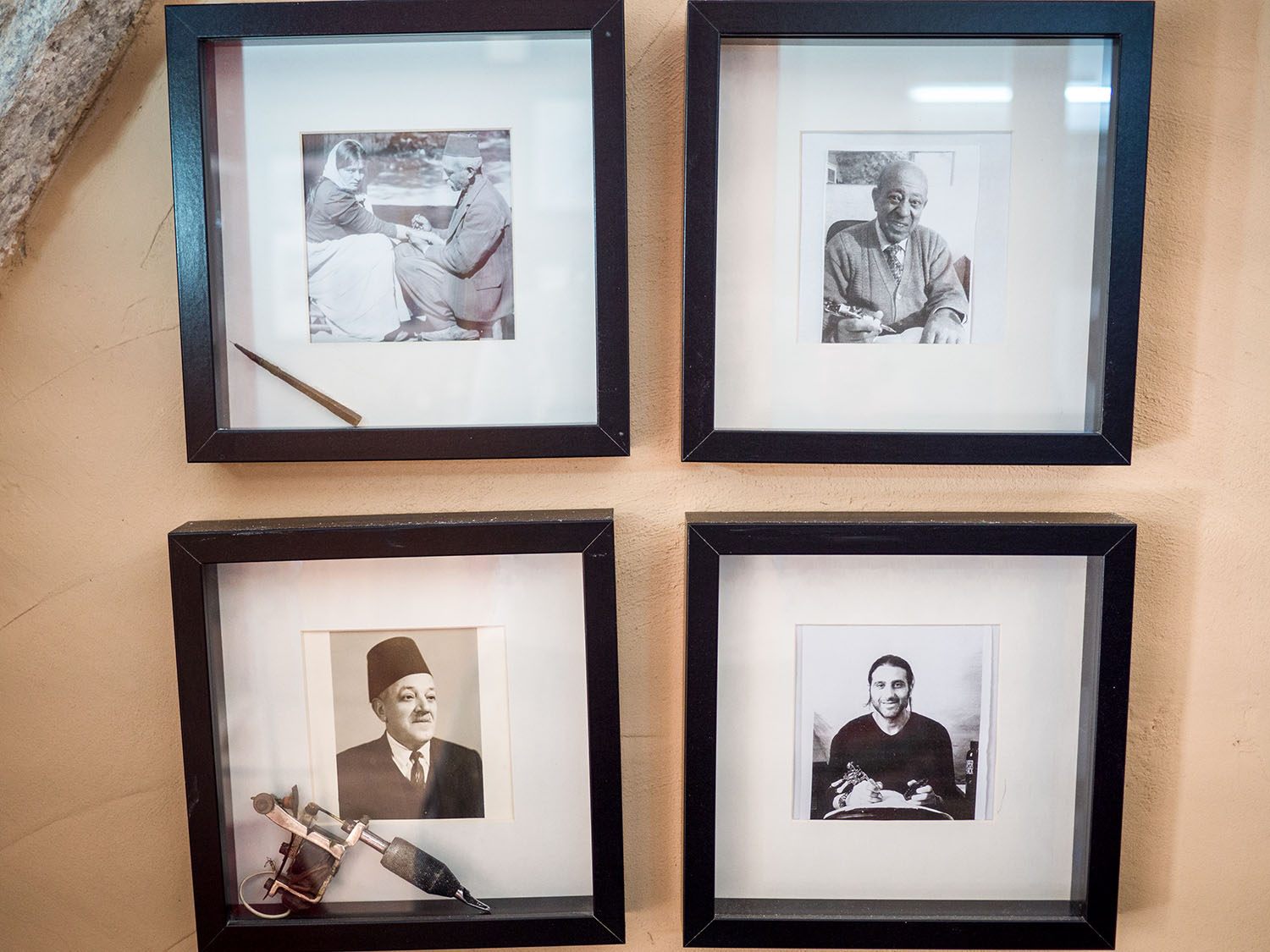
Photographs hang on the shop’s wall depicting the last four generations of Razzouk family tattooers: (counterclockwise from top left) Jirius (with hand tool), Yacoub (with early machine), Wassim, Anton.
Jirius, great-grandfather to the current generation of family tattooers at Razzouk Ink, settled in Jerusalem’s Old City in the late 19th century, bringing knowledge of tattooing and a set of antique stencil blocks that bore the traditional designs, one dating as far back as 1749. Several other families tattooed in the Holy Land at the time, including Armenian competitors in Jerusalem, with other practices in Bethlehem and Jaffa.
But during the Israeli War of Independence in 1947, many people of Palestinian heritage fled their homes, along with Coptic Christians like the Razzouks, who left for neighboring Jordan. Pilgrimage tattooing became a dying art. After the conflict cooled off, the Razzouks returned to Jerusalem, where they alone became the primary custodians of this craft. “After 1948, [Jirius’ son] Yacoub was the only tattooer left in Israel,” says Anton of his father, a situation that lasted until the 1960s, when Western-style tattooing began to emerge.
Yacoub became the sole practitioner of this service for the Coptic pilgrims who trekked to the Holy Land, particularly at Easter, to worship and mark their faith. Anton relates the story of one man whose arms were covered in dates—each representing a consecutive year of pilgrimage from the 1930s on. Following the Six-Day War in 1967, however, restrictions on travel to Israel by Egyptians made it considerably more difficult for these annual pilgrimages to happen.

St. George and the Dragon tattoo motif as tattooed from a stencil block that dates to 200 or 300 years ago.
The family carried on. Anton took over tattooing from his father, with a steady enough stream of customers. It seemed that the business might die with him, as none of his children were initially interested in carrying on the family craft. But several years ago, Anton’s son Wassim, who had gone to college for hospitality management, became interested in tattoos through his passion for motorcycle culture. The weight of 700 years of family heritage suddenly hit the young man, impelling him to preserve these tokens of faith and travel.
Wassim set about learning the business from his father (now retired) and arranged for mentorship by modern tattooers on new techniques and contemporary health and safety standards. In this post-AIDS era, gone are days of being able to use the same tattoo needles used over and over for a year or more, or staunching bleeding with bandages lifted from one customer and applied to the next. The melding of modern hygiene practices with hundreds of years of history allows this historic business to march into a future that must consider potential dangers like bloodborne pathogens, despite trusting in God to prevent unfortunate outcomes.
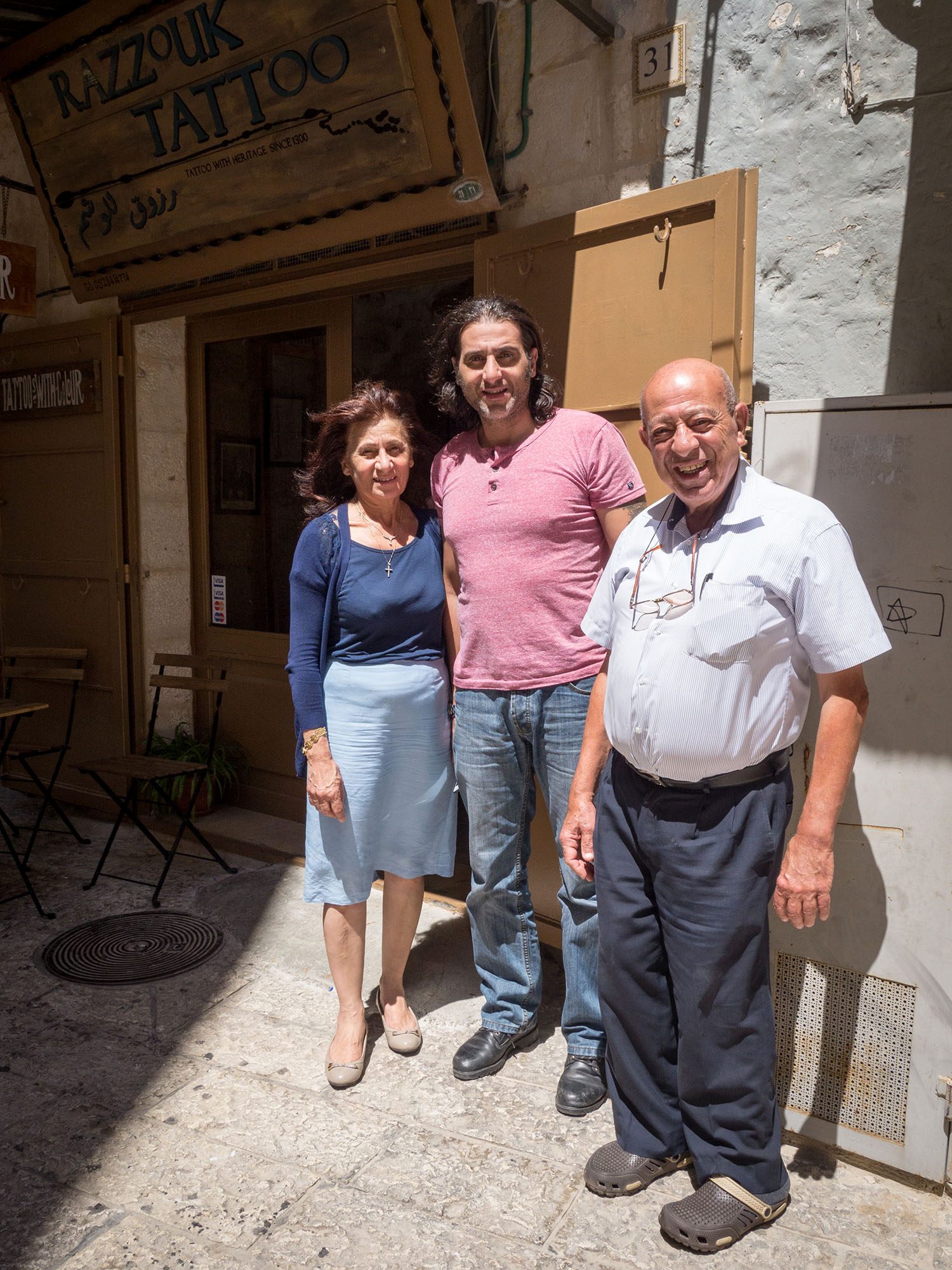
Wassim Razzouk with his parents; his father Anton is now retired from the tattoo business.
Wassim revitalized and reinvented the business, expanding beyond traditional pilgrimage tattoos to other genres. His wife Gabrielle joined him, and they work side by side. The family hopes that at least one of their children will follow in their footsteps, but seem disinclined to pressure any of them to do so, a testament to their faith in the power of heritage and a call to service that will likely emerge on its own.
Modern designs aside, the pilgrimage tattoos are what compel people to travel hundreds, even thousands of miles to the Razzouks’ shop. There’s nowhere else on Earth where one can get a traditional Christian design rendered from stencil blocks of such antiquity (some practitioners exist in Cairo, but they lack the Razzouk’s deep family history and collection of verified artifacts).

Wassim Razzouk inks a stencil block with carbon-paper ink to create a durable transfer to the skin.
Wassim has developed new techniques for inscribing traditional pilgrimage tattoos faster and better. He starts by rubbing the stencil block with purple ink from carbon-copy paper—a transfer medium used worldwide by contemporary tattooers for decades, but prior to Wassim’s innovation, never used for pilgrimage stamps. This offers significant benefit over the previous techniques, which would dip the block in stamp-pad ink or powdered charcoal—a fugitive transfer pattern subject to smearing and disappearing during the tattooing process.
Now, a durable purple guide holds fast to the skin while the image can be rendered permanently via machine. Although Wassim’s grandfather Yacoub pioneered the use of machines for pilgrimage tattoos, Wassim has perfected a technique that achieves a look that mimics what the blocks look like when printed on paper—he inscribes a first pass over the lines of the stencil, then he goes back and retraces every line, adding graphic weight and ensuring a bold, black motif visible from a distance.
In the 21st century, tattoos have emerged as popular travel souvenirs, but Razzouk Ink offers a truly unique experience—a link to hundreds of years of history through a visceral transaction of bloodletting and pain. While in that fuzzy zone that emerges from endorphins as a tattoo progresses, I channeled the many travelers who have endured a similar fate. And later, post healing, as the ink began to settle into my skin, a glance at the enduring mark conjured a heavy mix of memory and tradition.



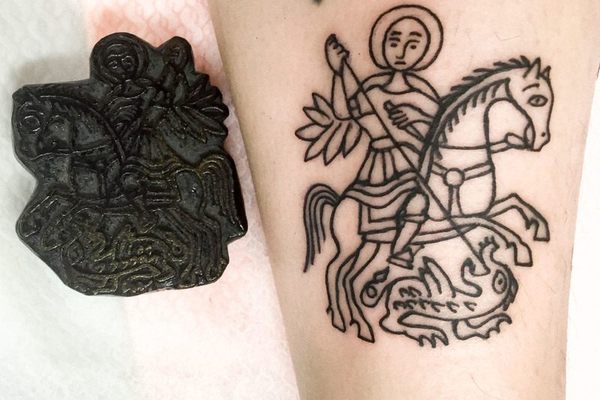




Follow us on Twitter to get the latest on the world's hidden wonders.
Like us on Facebook to get the latest on the world's hidden wonders.
Follow us on Twitter Like us on Facebook